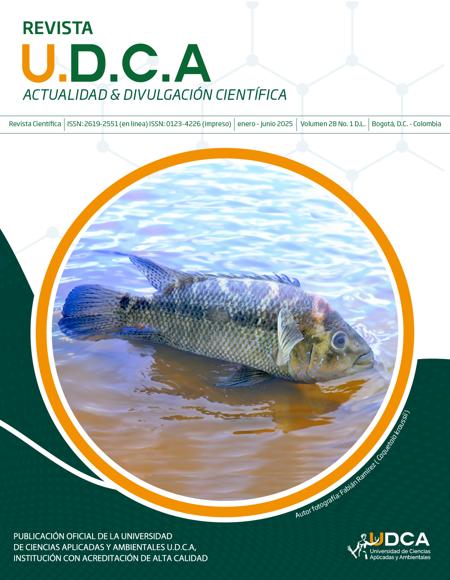Estímulos visuales, olfativos y nutricionales de la albahaca (Ocimum basilicum L.) en Tetragonisca angustula (Hymenoptera: Apidae)
Visual, olfactory, and nutritional stimuli of basil (Ocimum basilicum L.) in Tetragonisca angustula (Hymenoptera: Apidae)
Contenido principal del artículo
Resumen
Las abejas son importantes polinizadores que, mediante el uso de estímulos visuales y olfativos, localizan flores en busca de recursos nutricionales. Entre las plantas, las aromáticas se reconocen por sus propiedades medicinales, pero poco se conoce sobre los mecanismos que participan en la interacción con sus visitantes florales. Este trabajo tuvo como objetivo determinar cómo los estímulos visuales y olfativos de las flores de albahaca participan en la atracción de Tetragonisca angustula Illiger (1806) y cómo en esta interacción participan los microorganismos asociados a las flores. Para esto, se evaluó la atracción de las abejas de acuerdo con el tipo de flor y recurso ofrecido (néctar, polen o néctar + microorganismos) y se analizó la atracción de la abeja a volátiles de la planta, evaluando plantas con y sin flores, y la atracción hacia los microorganismos aislados en las mismas. Durante la primera fase (visual) las abejas de T. angústula prefirieron las flores blancas en forma de panícula y los recursos de néctar.; En la segunda fase (olfativa) eligieron plantas con flores sobre aquellas que no tienen. Cuando se ofrecieron las plantas junto con microorganismos aislados, las abejas prefirieron el olor de los microorganismos sobre el olor de las plantas con flores. La atracción de T. angustula a plantas de albahaca se ve influenciada por la estructura y color de las flores, así como por los volátiles emitidos y, especialmente, por la presencia de microorganismos en ellas, a pesar de que mayoritariamente buscan néctar como recurso durante la visita
Palabras clave:
Descargas
Datos de publicación
Perfil evaluadores/as N/D
Declaraciones de autoría
- Sociedad académica
- Universidad de Ciencias Aplicadas UDCA
- Editorial
- Universidad de Ciencias Aplicadas y Ambientales U.D.C.A
Detalles del artículo
Referencias (VER)
ACOSTA, M.; ALVARADO, Y.; CRUZ, M.; LEIVA, M.; DELGADO, L. 2005. Micobiota epífita y contaminantes fungosos del establecimiento in vitro de Eucalyptus grandis. Manejo Integrado de Plagas y Agroecología. 75:60-63.
AGRIOS, G.N. 2005. Plant pathology. Fifth edition. Elsevier Academic Press. EE. UU. 922p.
AIZEN, M.A.; VÁZQUEZ, D.P.; SMITH-RAMÍREZ, C. 2002. Historia natural y conservación de los mutualismos planta-animal del bosque templado de Sudamérica austral. Revista chilena de historia natural. 75(1):79-97. http://dx.doi.org/10.4067/S0716-078X2002000100008
ÁLVAREZ, L.J.; LUCIA, M.; RAMELLO, P.J.; PINO, M.D.; ABRAHAMOVICH, A.H. 2014. Abejas asociadas a cultivos de berenjena (Solanum melongena L., Solanaceae) en invernadero del Cinturón Hortícola de La Plata, Buenos Aires, Argentina. Revista de la Facultad de Agronomía. 113(2):211-217.
ASOCIACIÓN ESPAÑOLA DE ENTOMOLOGÍA; JARDÍN BOTÁNICO ATLÁNTICO; CENTRO IBEROAMERICANO DE LA BIODIVERSIDAD. 2002. Polinizadores y biodiversidad. Apolo Observatorio de Agentes Polinizadores. España. 160p. Available from Internet in: https://apolo.entomologica.es/cont/materiales/informe_tecnico.pdf
AVARGUÈS-WEBER, FINKE, V.; NAGY, M.; SZABÓ, T.; D’AMARO, D.; DYER, A.G.; FISER, J. 2020. Different mechanisms underlie implicit visual statistical learning in honey bees and humans. Proceedings of the National Academy of Sciences. 117(41):25923-25934. https://doi.org/10.1073/pnas.1919387117
CALÍN-SÁNCHEZ, Á.; LECH, K.; SZUMNY, A.; FIGIEL, A.; CARBONELL-BARRACHINA, Á.A. 2012. Volatile composition of sweet basil essential oil (Ocimum basilicum L.) as affected by drying method. Food Research International. 48(1):217-225. https://doi.org/10.1016/j.foodres.2012.03.015
CAÑEDO, T.; AMES, T. 2004. Manual de laboratorio para el manejo de hongos entomopatógenos. International Potato Center. 62p.
CANO, M.A. 2011. Interacción de microorganismos benéficos en plantas: micorrizas, Trichoderma spp. y Pseudomonas spp. Una revisión. Revista U.D.C.A Actualidad & Divulgación Científica. 14(2):15-31. https://doi.org/10.31910/rudca.v14.n2.2011.771
CARMONA-DÍAZ, G.; GARCÍA-FRANCO, J.G.; HERNÁNDEZ CARMONA, S.; RETURETA APONTE. A.; QUINTANA MORALES, P.C.; LÓPEZ GALINDO, A.; GARCÍA ORDUÑA, F. 2017. Forrajeo y polinización del arbusto Malpighia glabra (Malpighiaceae) y la orquídea Oncidium cosymbephorum (Orchidaceae) por abejas Centris (Apidae) en la isla Agaltepec, Veracruz, México. eNeurobiología. 8(19):181217.
CARVALHO, A.M.; BEGO, L.R. 1995. Seasonality of dominant species of bees in the Panga Ecological Reserve, Cerrado, Uberlândia, MG. Anais da Sociedade Entomológica do Brasil. 24(2):329-337. https://doi.org/10.37486/0301-8059.v24i2.1034
CASTRO-RESTREPO, D.; DOMINGUEZ, M.I.; GAVIRIA-GUTIÉRREZ, B.; OSORIO, E.; SIERRA, K. 2022. Biotization of endophytes Trichoderma asperellum and Bacillus subtilis in Mentha spicata microplants to promote growth, pathogen tolerance and specialized plant metabolites. Plants. 11(11):1474. https://doi.org/10.3390/plants11111474
CHALCHAT, J.C.; ÖZCAN, M.M. 2008. Comparative essential oil composition of flowers, leaves and stems of basil (Ocimum basilicum L.) used as herb. Food Chemistry. 110(2):501-503. Https://doi.org/10.1016/j.foodchem.2008.02.018
CLARKE, S.C. 2018. Collins and Lyne’s Microbiological Methods. British Journal of Biomedical Science. 61(2):113. https://doi.org/10.1080/09674845.2004.11978056
CRAWLEY, M.J. 2012. The R book. John Wiley & Sons. 1051p. https://doi.org/10.1002/9781118448908
DAGENAIS, T.R.; KELLER, N.P. 2009. Pathogenesis of Aspergillus fumigatus in invasive aspergillosis. Clinical Microbiology Reviews. 22(3):447-465. https://doi.org/10.1128/CMR.00055-08
DAVIS, T.S.; BOUNDY-MILLS, K.; LANDOLT, P.J. 2012. Volatile emissions from an epiphytic fungus are semiochemicals for eusocial wasps. Microbial Ecology. 64(4):1056-1063. Https://doi.org/10.1007/s00248-012-0074-2
DE BRUYNE, M.; BAKER, T.C. 2008. Odor detection in insects: volatile codes. Journal of Chemical Ecology. 34(7):882-897. https://doi.org/10.1007/s10886-008-9485-4
DICKSCHAT, J.S.; CELIK, E.; BROCK, N.L. 2018. Volatiles from three genome sequenced fungi from the genus Aspergillus. Beilstein Journal of Organic Chemistry. 14(1):900-910. Https://doi.org/10.3762/bjoc.14.77
FOLEY, K.; FAZIO, G.; JENSEN, A.B.; HUGHES, W.O. 2014. The distribution of Aspergillus spp. opportunistic parasites in hives and their pathogenicity to honeybees. Veterinary Microbiology. 169(3-4):203-210. https://doi.org/10.1016/j.vetmic.2013.11.029
GARCÍA-CONDE, K.B.; CERNA-CHÁVEZ, E.; OCHOA-FUENTES, Y.M.; VELÁZQUEZ-GUERRERO, J.J. 2024. Aspergillus oryzae: Una oportunidad para la agricultura. Revista mexicana de fitopatología. 42(1). https://doi.org/10.18781/r.mex.fit.2302-2
GARCÍA-GARCÍA, M.C.; ORTIZ, P.L.; DÍEZ DAPENA, M.J. 2001. Pollen collecting behaviour of Apis mellifera during one day. Grana. 40(4–5):205-209. https://doi.org/10.1080/001731301317223141
GERMAINE, K.; KEOGH, E.; GARCIA-CABELLOS, G.; BORREMANS, B.; LELIE, D.; BARAC, T.; OEYEN, L.; VANGRONSVELD, J.; MOORE, F.P.; MOORE, E.R.B.; CAMPBELL, C.D.; RYAN, D.; DOWLING, D.N. 2004. Colonisation of poplar trees by gfp expressing bacterial endophytes. FEMS Microbiology Ecology. 48(1):109–118. https://doi.org/10.1016/j.femsec.2003.12.009
GIURFA, M. 2013. Cognition with few neurons: higher-order learning in insects. Trends in Neurosciences. 36(5):285–294. https://doi.org/10.1016/j.tins.2012.12.011
GIURFA, M.; EICHMANN, B.; MENZEL, R. 1996. Symmetry perception in an insect. Nature. 382(6590):458-461. https://doi.org/10.1038/382458a0
GONZÁLEZ-ZÚÑIGA, J.A.; GONZÁLEZ-SÁNCHEZ, H.M.; GONZÁLEZ-PALOMARES, S.; ROSALES-REYES, T.; ANDRADE-GONZÁLEZ, I. 2011. Microextracción en fase sólida de compuestos volátiles en albahaca (Ocimum basilicum L.). Acta Universitaria. 21(1):17-22. https://doi.org/10.15174/au.2011.48
GRANADOS-SÁNCHEZ, D.; LÓPEZ-RÍOS, G.F.; HERNÁNDEZ-GARCÍA, M.Á.; SÁNCHEZ-GONZÁLEZ, A. 2003. Ecología de las plantas epífitas. Revista Chapingo. Serie Ciencias Forestales y del Ambiente. 9(2):101–111.
HALLMANN, J.; QUADT-HALLMANN, A.; MAHAFFEE, W.F.; KLOEPPER, J.W. 1997. Bacterial endophytes in agricultural crops. Canadian Journal of Microbiology. 43(10):895–914. https://doi.org/10.1139/m97-131
HEMPEL DE IBARRA, N.; HOLTZE, S.; BÄUCKER, C.; SPRAU, P.; VOROBYEV, M. 2022. The role of colour patterns for the recognition of flowers by bees. Philosophical Transactions of the Royal Society. 377(1862):20210284. http://doi.org/10.1098/rstb.2021.0284
HÜE, T.; CAUQUIL, L.; FOKOU, J.H.; DONGMO, P.J.; BAKARNGA-VIA, I.; MENUT, C. 2015. Acaricidal activity of five essential oils of Ocimum species on Rhipicephalus (Boophilus) microplus larvae. Parasitology Research. https://doi.org/10.1007/s00436-014-4164-6
HUNG, K.L.J.; KINGSTON, J.M.; ALBRECHT, M.; HOLWAY, D.A.; KOHN, J.R. 2018. The worldwide importance of honeybees as pollinators in natural habitats. Proceedings of the Royal Society B: Biological Sciences. 285(1870):20172140. http://doi.org/10.1098/rspb.2017.2140
JIANG, Y.; YE, J.; LI, S.; NIINEMETS, Ü. 2016. Regulation of floral terpenoid emission and biosynthesis in sweet basil (Ocimum basilicum). Journal of Plant Growth Regulation. 35:921–935. https://doi.org/10.1007/s00344-016-9591-4
KLEIN, A.M.; VAISSIERE, B.E.; CANE, J.H.; STEFFAN-DEWENTER, I.; CUNNINGHAM, S.A.; KREMEN, C.; TSCHARNTKE, T. 2007. Importance of pollinators in changing landscapes for world crops. Proceedings of the Royal Society B: Biological Sciences. 274(1608):303–313. https://doi.org/10.1098/rspb.2006.3721
KONEMAN, A.; DOWELL, S. 1989. Diagnóstico microbiológico. Texto y atlas color. 2ª ed. Ed. Panamericana (México).
LOPES DE CARVALHO, C.A.; MARCHINI, L.C. 1999. Tipos polínicos coletados por Nannotrigona testaceicornis e Tetragonisca angustula (Hymenoptera, Apidae, Meliponinae). Scientia Agricola. 56:717-722. https://doi.org/10.1590/S0103-90161999000300029
LÓPEZ-ÁVILA, A.; RINCÓN, D.F. 2006. Diseño de un olfatómetro de flujo de aire para medir respuestas olfativas de insectos de tamaño mediano y pequeño. Ciencia y Tecnología Agropecuaria. 7(1):61–65. https://doi.org/10.21930/rcta.vol7_num1_art:61
MATU, F.K.; MURUNGI, L.K.; MOHAMED, S.; DELETRE, E. 2021. Behavioral response of the greenhouse whitefly (Trialeurodes vaporariorum) to plant volatiles of Ocimum basilicum and Tagetes minuta. Chemoecology. 31(1):47–62. https://doi.org/10.1007/s00049-020-00327-z
MENZEL, R. 2001. Behavioral and neural mechanisms of learning and memory as determinants of flower constancy. In: Chittka, L.; Thomson, J.D. (eds). Cognitive ecology of pollination. Ed. Cambridge University Press. p.21–40. https://doi.org/10.1017/CBO9780511542268.003
MICHENER, C.D. 2007. The bees of the world. second edition. Johns Hopkins University Press. EE.UU. 992p.
MORÉ, E.; FANLO, M.; MELERO, R.; CRISTÓBAL, R. 2010. Guía para la producción sostenible de plantas aromáticas y medicinales. Centre Tecnològic Forestal de Catalunya. 265p. Available from Internet in: https://apsb.ctfc.cat/docs/GUIA%20PAM-CASTELLAfinal.pdf
MURILLO PEREA, E.; VIÑA PATIÑO, A. 1999. Determinación de los constituyentes volátiles de la albahaca (Ocimum spp.) mediante dos métodos de extracción. Revista Colombiana de Química. 28(1):65-74.
MURILLO, E.; FERNÁNDEZ, K.; SIERRA, D.; VIÑA, A. 2004. Caracterización fisicoquímica del aceite esencial de albahaca. II. Revista Colombiana de Química. 33(2):139-148.
OCAÑA-CABRERA, J.S.; LIRIA, J.; VIZUETE, K.; CHOLOTA-IZA, C.; ESPINOZA-ZURITA, F.; SAEGERMAN, C.; MARTIN-SOLANO, S.; RON-ROMÁN, J. 2022. Pollen preferences of stingless bees in the Amazon region and southern highlands of Ecuador by scanning electron microscopy and morphometry. PLOS One. 17(9):e0272580. https://doi.org/10.1371/journal.pone.0272580
OLLERTON, J. 2021. Pollinators and pollination: nature and society. Pelagic Publishing Ltd. Reino Unido. 336p.
PARRA, G.N. 2001.Guía para la cría y manejo de la abeja Angelita o Virginita Tetragonisca angustula Illiger. Serie Ciencia y tecnología. No. 84. Convenio Andrés Bello. Colombia. 43p.
PEÑUELAS, J.; FARRÉ-ARMENGOL, G.; LLUSIA, J.; GARGALLO-GARRIGA, A.; RICO, L.; SARDANS, J.; TERRADAS, J.; FILELLA, I. 2014. Removal of floral microbiota reduces floral terpene emissions. Scientific Reports. 4(1):6727. https://doi.org/10.1038/srep06727
PHOTITA, W.; LUMYONG, S.; LUMYONG, P.; MCKENZIE, E.H.C.; HYDE, K.D. 2004. Are some endophytes of Musa acuminata latent pathogens? Fungal Diversity. 16:131–140.
R DEVELOPMENT CORE TEAM. 2020. R: A language and environment for statistical computing. R Foundation for Statistical Computing (Austria). Available from Internet in: https://www.R-project.org/
ROSENBLUETH, M.; MARTÍNEZ-ROMERO, E. 2006. Endófitos bacterianos y sus interacciones con los huéspedes. Interacciones moleculares planta-microbio. 19(8):827-837. https://doi.org/10.1094/MPMI-19-0827
SANGIORGIO, D.; CELLINI, A.; SPINELLI, F.; PASTORE, C.; FARNETI, B.; SAVIOLI, S.; RODRIGUEZ-ESTRADA, M.T.; DONATI, I. 2022. Contribution of fruit microbiome to raspberry volatile organic compounds emission. Postharvest Biology and Technology (Países Bajos). 183:111742. https://doi.org/10.1016/j.postharvbio.2021.111742
SILVA LIMA, A.; MILHOMEM, M.N.; SANTOS MONTEIRO, O.; PEREIRA ARRUDA, A.C.; MARTINS DE CASTRO, J.A.; LOPES FERNANDES, Y.M.; SOARES MAIA, J.G.; COSTA-JUNIOR, L.M. 2018. Seasonal analysis and acaricidal activity of the thymol-type essential oil of Ocimum gratissimum and its major constituents against Rhipicephalus microplus (Acari: Ixodidae). Parasitology Research. 117:59-65. https://doi.org/10.1007/s00436-017-5662-0
SLAA, E.J.; SÁNCHEZ CHAVES, L.A.; MALAGODI-BRAGA, K.S.; HOFSTEDE, F.E. 2006. Stingless bees in applied pollination: Practice and perspectives. EDP Sciences Apidologie. 37(2):293-315. https://doi.org/10.1051/apido:2006022
SRINIVASAN, M. V.; ZHANG, S. W.; WITNEY, K. 1994. Visual discrimination of pattern orientation by honeybees: performance and implications for 'cortical' processing. Philosophical Transactions of the Royal Society of London. Series B: Biological Sciences. 343(1304):199-210. https://doi.org/10.1098/rstb.1994.0021
SRINIVASAN, M.V.; ZHANG, S. W.; ZHU, H. 1998. Honeybees link sights to smells. Nature. 396(6712):637-638. https://doi.org/10.1038/25272
STEINER, S.; ERDMANN, D.; STEIDLE, J.L.; RUTHER, J. 2007. Host habitat assessment by a parasitoid using fungal volatiles. Frontiers in Zoology. 4:3. Https://doi.org/10.1186/1742-9994-4-3
STONE, J.K.; POLISHOOK, J.D.; WHITE, J.F. 2004. Endophytic fungi. In: Mueller, G. M.; Bills, G. F.; Foster, M. S. (eds). Biodiversity of fungi: inventory and monitoring methods. Elsevier Academic Press. EEUU. p.241-270.
SUNESSON, A.L.; VAES, W.; NILSSON, C.; BLOMQUIST, G.; ANDERSSON, B.; CARLSON, R. 1995. Identification of volatile metabolites from five fungal species cultivated on two media. Applied and Environmental Microbiology. 61(8):2911-2918. Https://doi.org/10.1128/aem.61.8.2911-2918.1995.
TORRETTA, J.P.; MEDAN, D.; ROIG ALSINA, A.; MONTALDO, N.H. 2010. Visitantes florales diurnos del girasol (Helianthus annuus, Asterales: Asteraceae) en la Argentina. Revista de la Sociedad Entomológica Argentina. 69(1-2):17-32.
TSAVKELOVA, E.A.; CHERDYNTSEVA, T.A.; BOTINA, S.G.; NETRUSOV, A.I. 2007. Bacteria associated with orchid roots and microbial production of auxin. Microbiological Research. 162(1):69-76. https://doi.org/10.1016/j.micres.2006.07.014
VANNETTE, R.L. 2020. The floral microbiome: plant, pollinator, and microbial perspectives. Annual Review of Ecology, Evolution, and Systematics. 51(1):363-386. https://doi.org/10.1146/annurev-ecolsys-011720-013401
VÉLEZ, P.E.; POSADA, F.J.; MARÍN, P.; GONZALEZ, M.T.; OSORIO, E.; BUSTILLO, A.E. 1997. Técnicas para el control de calidad de formulaciones de hongos entomopatógenos. Cenicafé. 24p.
WOODCOCK, T.S.; LARSON, B.M.H.; KEVAN, P.G.; INOUYE, D.W.; LUNAU, K. 2014. Flies and flowers II: floral attractants and rewards. Journal of Pollination Ecology. 12:63-94. https://doi.org/10.26786/1920-7603(2014)5







